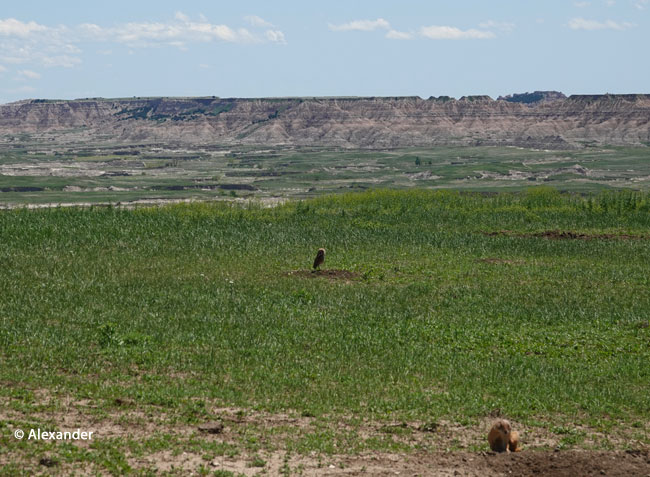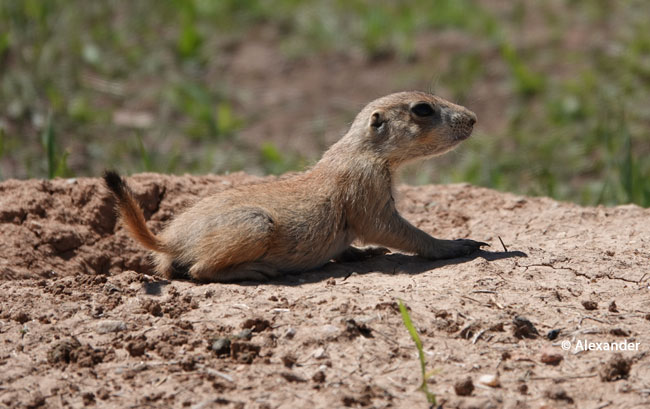On a trip last month to the grasslands of South Dakota, the presence of abundant black-tailed prairie dogs was a highlight.
We were lucky to be there in mid-May, only about a month after the adult females had given birth. They produce one litter per spring, with usually three or four young.
Below, the mother is on the right with her three young ones.

Here you can see the mother with her little one leaping in the background.

It is fun to watch them because they are fast, mischievous and energetic.
Prairie dogs are rodents in the squirrel family, and in South Dakota they are primarily found in the state’s west. The population is considered stable in the state, although the overall population has drastically declined with the loss of prairie habitats. See range map at end.

Found in the Great Plains of North America, Cynomys ludovicianus are often considered a nuisance to ranchers but they are an important element of healthy prairies.
In 1804, millions of prairie dogs co-existed with other plants and animals on the Great Plains. Their colonies stretched from Canada to Mexico. Lewis and Clark wrote about them, and later, John James Audubon created an artistic series “The Viviparous Quadrupeds of North America” that included the Prairie Dog, below. Plate 99 from 1845.

Today, black-tailed prairie dog colonies cover just one percent of their historical range.
They are considered a keystone species, i.e. they have a disproportionately large effect on the prairie environment and play a critical role in its success. Without keystone species, an ecosystem can cease to exist.
Their abandoned burrows provide shelter and protection for other animals, predators depend on them for survival, their constant digging provides soil aeration, and their grass-eating upkeep develops healthy grasslands.
They have colonies, also called towns, that are recognizable by the mounds at the burrow entrances. In the prairie dog town pictured below, there is one upright prairie dog visible, several running, and many mounds.

There are hundreds of prairie dog mounds in the photo below, as well as a herd of bison. The mounds look like sandy patches in the green grass.
Bison use the dusty mounds for wallowing, take dust baths to relieve skin irritations. Many times we saw bison wriggling on their backs, all four legs suspended in the air.

A prairie dog colony will typically have 30-50 burrow entrances per acre.
The tunnels are about 3-6 feet (1-2 m) below the surface and about 15 feet (4.5 m) long. Burrow systems have several chambers, including one near the surface where the prairie dog can sit and listen for activity.

Burrows are used for breeding, rearing young, and hiding from predators and are maintained from generation to generation.
More info: Black-tailed Prairie Dog, Wikipedia
One day in The Badlands we found three different burrowing owls on prairie dog burrows.


Prairie dogs are 12-16 inches (30-40 cm) in length and weigh 1-2 pounds (0.5-1.5 kg). They have short, muscular legs and long claws, perfect for their burrowing lifestyle.
They eat a wide variety of grasses and forbs.

Prairie dogs have excellent hearing and have an elaborate communication system and sophisticated social structure. They have at least 11 different alarm calls identifying the immediate threat.
This video link below gives you an idea of their barking sounds for which they are named.
Link: YouTube Video Barking Prairie Dogs.
Unfortunately these little cuties have a lot of predators. Black-footed ferrets, badgers, bobcats, golden eagles, some hawk species and rattlesnakes prey on them.
Their most common predator is coyotes. This coyote, below, was in pursuit of something else, but the prairie dogs were intensely aware of it and staying close to their burrows.

When prairie dogs sense danger there are several mechanisms we witnessed, in addition to the barking.
One is the jump-yip display. The animal will stretch its body vertically and throw its forefeet into the air while calling.
But since they are quite small and their voices so shrill, it looked more like a small, trained animal doing a trick…a little bitty back flip.
Also, the young ones, when scared, had a three-part behavior, shown below. They would scurry back to their burrow, look around.
Then they would remain upright and vigilantly bark, the little tail twitching with each squeak.

Then they hunched down, belly to the ground (below).

And then they flattened completely.

On the day it rained, we were surprised to find the prairie dog town had no prairie dogs in sight. Where it had been active the day before, on this rainy day it looked abandoned.
Even in South Dakota where there are bitter winters, these colonies do not migrate. They don’t even entirely hibernate.
The animal puts on fat and stores food in the burrows. Sometimes they leave the burrow to forage, and at night will enter a state of torpor (lowered metabolism) to conserve energy. They typically lose twenty percent of their body weight during the fall and winter.
But in the spring the big open skies were often blue with puffy, white clouds and prairie dogs were running in every direction.
Their busy lives and social existence were in full swing.
Written by Jet Eliot.
Photos by Athena Alexander.

